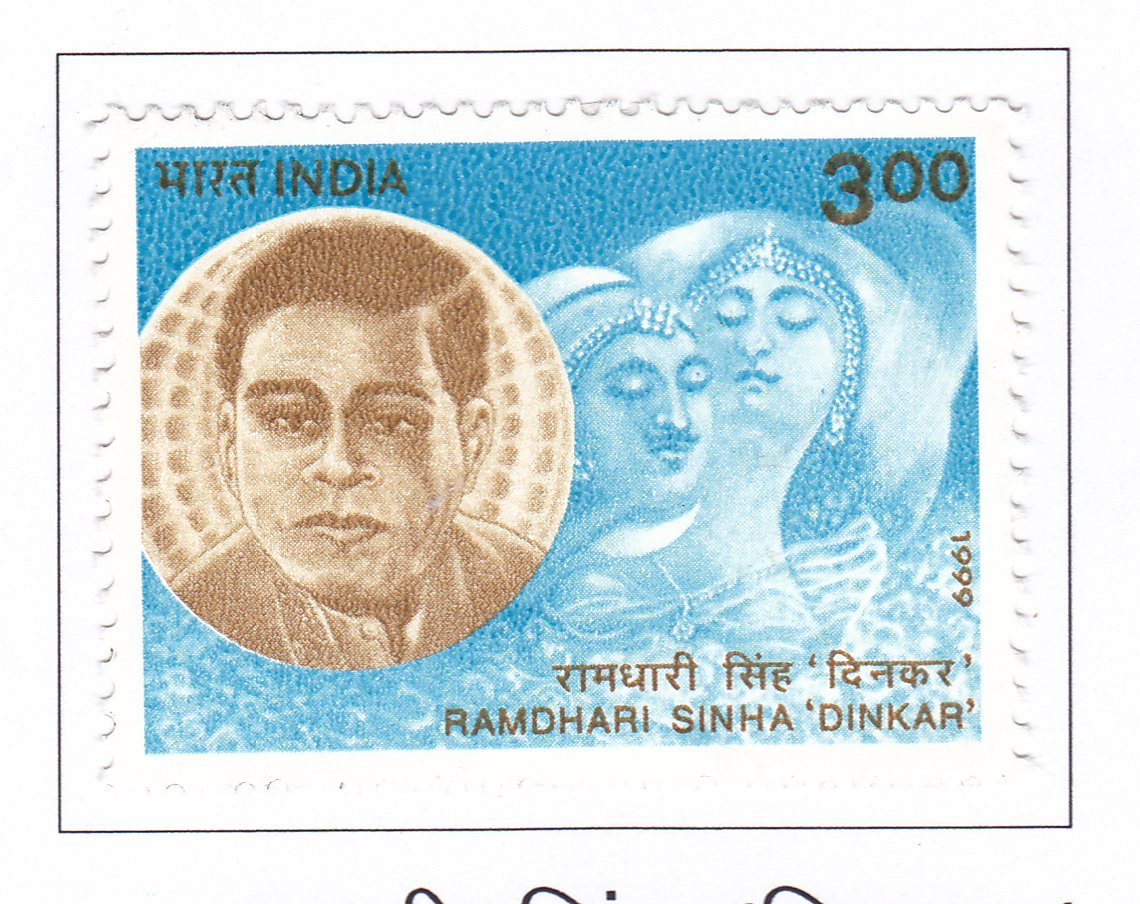Linguistic Harmony Of India – Ramdhari Sinha ‘Dinkar’ (1908-1974)

Technical Data
| Stamp Set | Linguistic Harmony Of India |
|---|---|
| Date of Issue | September 14, 1999 |
| Denomination | Rs. 3 |
| Perforation | comb 13½ |
| Printer | Security Printing Press, Nashik |
| Watermark | No Watermark |
| Colors | Multicolor |
| Catalog Codes |
Michel IN 1700 Stamp Number IN 1762 Yvert et Tellier IN 1467 Stanley Gibbons IN 1862 |
| Themes | Authors | Commemoration | Famous people | Literary People (Poets and Writers) | Literature |
Table of Contents
Ramdhari Sinha ‘Dinkar’ and Linguistic Harmony in India
Ramdhari Sinha ‘Dinkar’ (1908–1974), one of India’s most celebrated poets, is remembered for his powerful nationalist writings and his contribution to linguistic harmony in India. Known as the “Rashtrakavi” or National Poet, Dinkar’s works reflected a deep love for his country, its diverse linguistic traditions, and his belief in the unity of Indian culture. Through his poetry, he sought to transcend regional and linguistic divides, emphasizing the oneness of India.
Early Life and Literary Beginnings
Born in Simaria, Bihar, Dinkar grew up in an environment rich in Hindi and Maithili linguistic traditions. Despite economic hardships, his passion for learning and literature led him to immerse himself in India’s literary and cultural heritage. As a student, he was heavily influenced by the writings of Rabindranath Tagore, Bankim Chandra Chattopadhyay, and Mahatma Gandhi, whose works reflected an underlying harmony of diverse Indian languages and cultures.
Dinkar’s early literary career began during India’s freedom struggle, when he started writing patriotic poetry that inspired millions. His poems reflected the revolutionary spirit of the time, but they also carried a message of unity and brotherhood, drawing on India’s linguistic and cultural diversity.
Advocate for Hindi and National Unity
Dinkar was a staunch advocate for the Hindi language, which he believed could act as a unifying force in India’s diverse linguistic landscape. However, he was equally respectful of other Indian languages and cultures. In his vision of a united India, Hindi would serve as a link language, while other regional languages would flourish alongside it, creating a harmonious linguistic mosaic.
In his essays and speeches, Dinkar emphasized the need for mutual respect between different linguistic communities. He was aware of the delicate balance required to maintain India’s linguistic harmony and frequently called for the promotion of regional languages like Tamil, Telugu, Bengali, and others, while advocating for Hindi as a common language to bridge cultural gaps.
Poetry as a Medium of Linguistic and Cultural Unity
Dinkar’s poetry often drew on the shared cultural heritage of India, incorporating elements from various regions and languages. His works are known for their classical references to Indian mythology and history, which resonated with readers from different linguistic backgrounds. In his famous epic “Rashmirathi”, Dinkar reimagines the story of Karna from the Mahabharata, drawing on themes of justice, duty, and human values, which appealed to audiences across India, regardless of linguistic differences.
Dinkar was also known for his deep admiration of other Indian poets and writers, such as Subramania Bharati and Kazi Nazrul Islam, who promoted similar ideals of linguistic and cultural unity. His works reflected a spirit of cultural inclusivity, transcending the barriers of language and region, and promoting a sense of national unity rooted in India’s diverse linguistic traditions.
Role in Post-Independence India
After India’s independence, Dinkar’s influence extended beyond the realm of literature into the political and cultural spheres. As a member of the Rajya Sabha, he actively worked to promote national unity through linguistic harmony, supporting initiatives that encouraged the coexistence of multiple languages. He played a key role in language debates, advocating for policies that respected India’s linguistic diversity while promoting Hindi as a common medium for communication.
Dinkar’s poem “Sanskriti ke Chaar Adhyay” (Four Chapters of Culture) is a profound reflection on India’s rich cultural and linguistic heritage. In this work, he discusses how India’s unity has always been based on the intermingling of different cultures and languages, emphasizing that linguistic and cultural harmony is essential for national integration.
Legacy of Linguistic Harmony
Ramdhari Sinha ‘Dinkar’ remains a symbol of India’s linguistic and cultural unity. His life and works continue to inspire generations, reminding us of the importance of mutual respect, tolerance, and unity in diversity. His poetry and advocacy for Hindi, while respecting other languages, stand as a testament to his belief in linguistic harmony as the foundation of national unity.
The Department of Posts has honored Dinkar’s legacy by issuing commemorative stamps, celebrating his contributions to Indian literature, culture, and his efforts to promote linguistic harmony. His works continue to resonate with people across India, serving as a bridge between different linguistic communities and highlighting the shared cultural values that bind the nation together.
